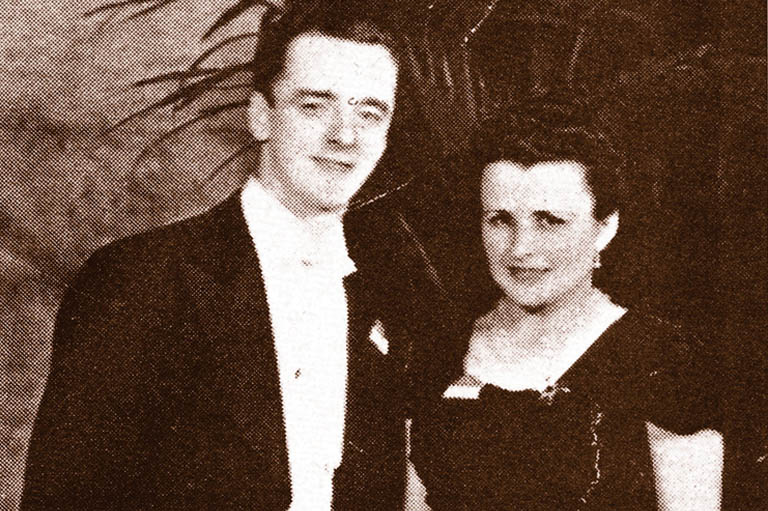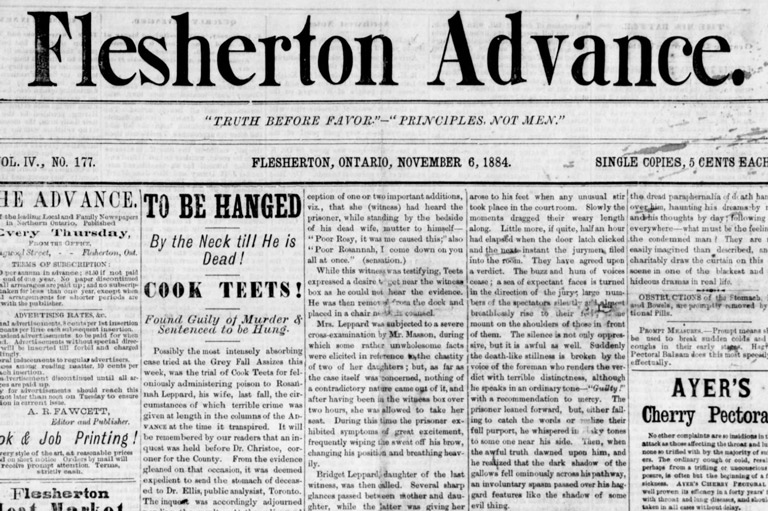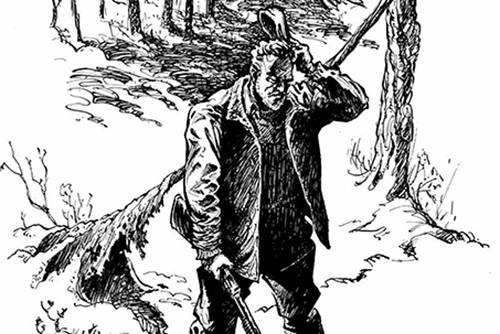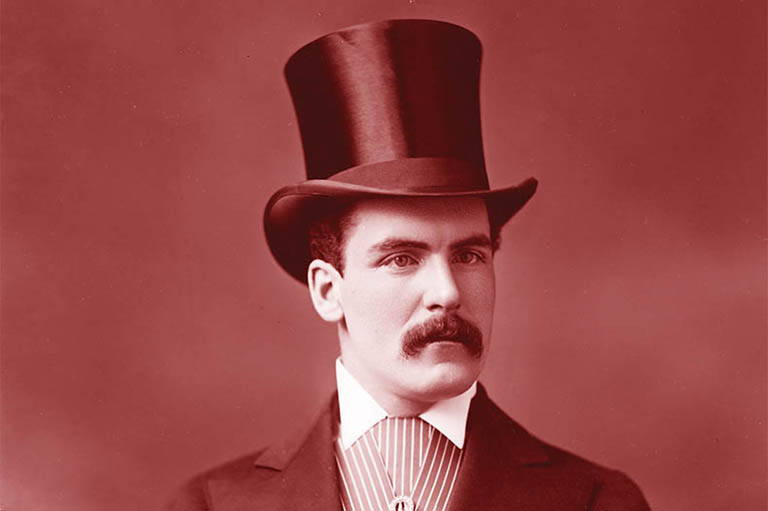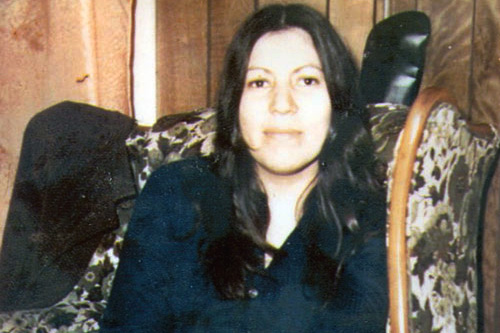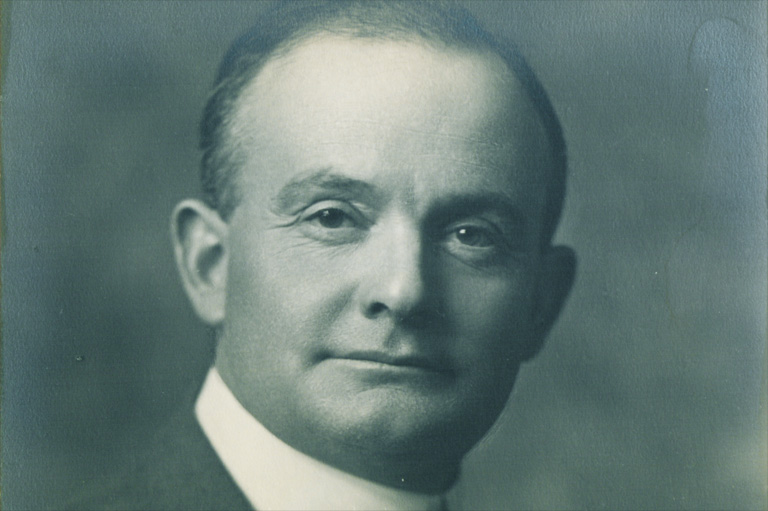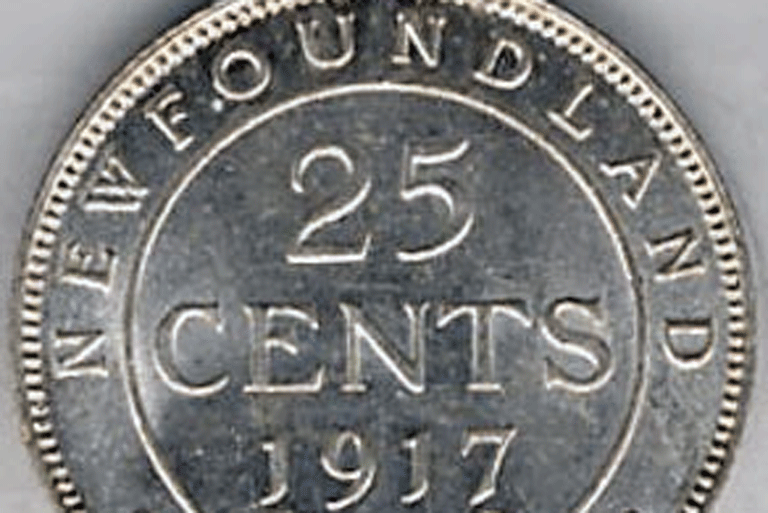Murder in Hastings County
The Aylward case is forgotten now.
The sight of a young married couple hanged together for a murder must have stuck in the memory of the thousands who jammed into Belleville, Canada West, on that bitterly cold Monday morning, December 8, 1862.
But those people are all dead now. So is a society that could hang Mary Aylward, a young woman mad enough to convict herself with her own tongue, abandoning her three small children, one of them still a babe in arms.
As for Richard Aylward, her husband, what precisely was the crime that brought him to the gallows and turned his children into orphans?
Story continues below...
Photo Gallery
-
 Roman Catholic Church in Belleville, Ontario, circa 1855.National Archives of Canada / C-020199
Roman Catholic Church in Belleville, Ontario, circa 1855.National Archives of Canada / C-020199 -
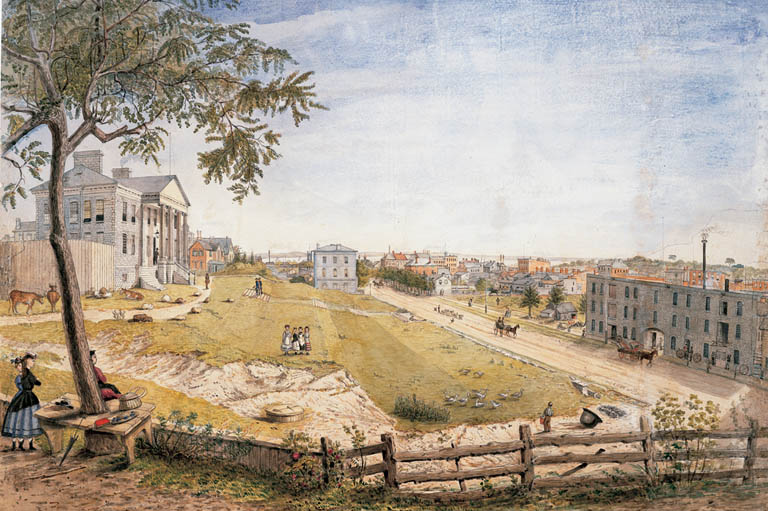 Hastings County Courthouse and Gaol, Belleville, circa 1870, watercolour and graphite on paper, by George Ackerman (1803-1891).Collection of Confederation Centre Art Gallery, Charlottetown / Gift of Lorna Bater and Doren Parker / CAG 98.5.1
Hastings County Courthouse and Gaol, Belleville, circa 1870, watercolour and graphite on paper, by George Ackerman (1803-1891).Collection of Confederation Centre Art Gallery, Charlottetown / Gift of Lorna Bater and Doren Parker / CAG 98.5.1 -
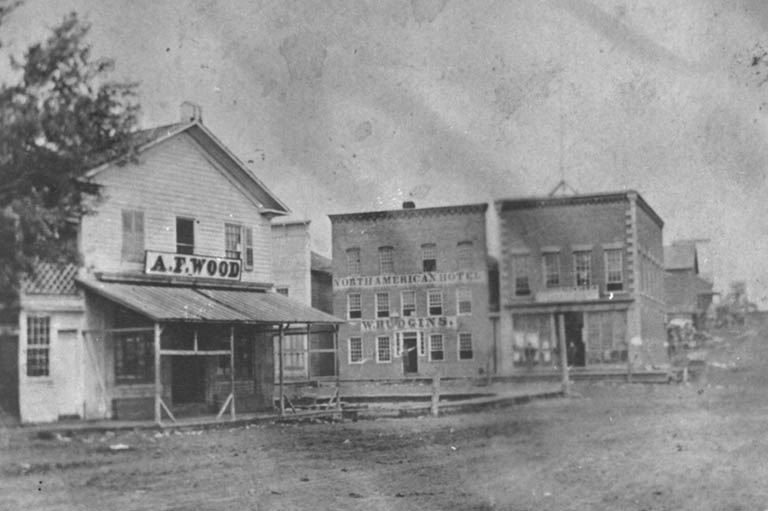 When the constable taking the Aylwards to jail in Belleville stopped for refreshments in Madoc (shown here in the 1860s), two of the prime pieces of evidence, the scythe and the shotgun, were taken by an unknown person.Hastings County Historical Society HC-2083
When the constable taking the Aylwards to jail in Belleville stopped for refreshments in Madoc (shown here in the 1860s), two of the prime pieces of evidence, the scythe and the shotgun, were taken by an unknown person.Hastings County Historical Society HC-2083 -
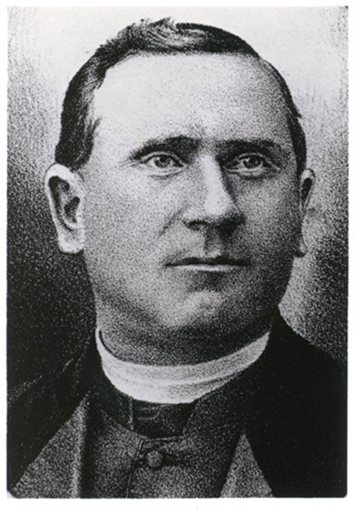 The Reverend John Brennan, St. Michael's first curate and nephew to Michael Brennan, accompanied the Aylwards to the scaffold.St. Michael's Roman Catholic Church Archives
The Reverend John Brennan, St. Michael's first curate and nephew to Michael Brennan, accompanied the Aylwards to the scaffold.St. Michael's Roman Catholic Church Archives -
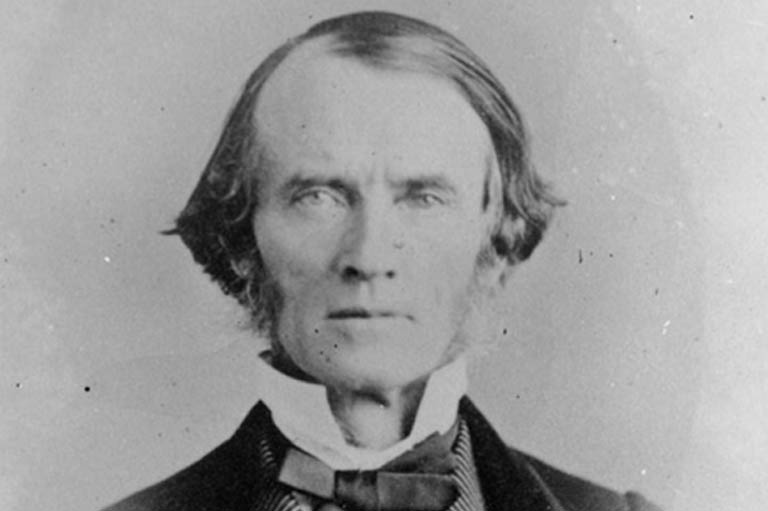 In 1862, John Sandfield Macdonald (1812-1872) was leader and attorney general in the Reform gov't of the Prov. of Canada. A Roman Catholic in a largely Protestant bloc, he was put in an unenviable position by the publicity surrounding the Aylward trail.National Archives of Canada / PA 12855
In 1862, John Sandfield Macdonald (1812-1872) was leader and attorney general in the Reform gov't of the Prov. of Canada. A Roman Catholic in a largely Protestant bloc, he was put in an unenviable position by the publicity surrounding the Aylward trail.National Archives of Canada / PA 12855 -
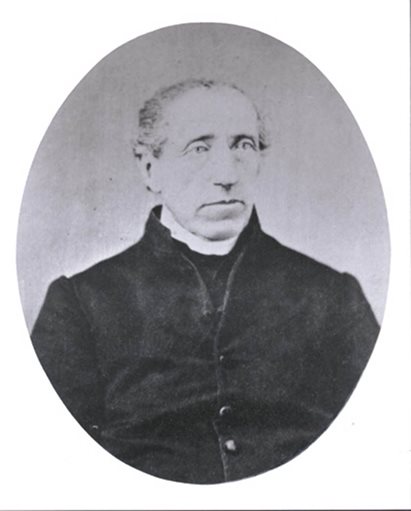 The Reverend Michael Brennan (1796-1869), first pastor of St.Michael's Roman Catholic Church, Belleville, was one of the leaders of sympathizers who sought to have the death penalty for Richard and Mary Aylward rescinded.St. Michael's Roman Catholic Church Archives
The Reverend Michael Brennan (1796-1869), first pastor of St.Michael's Roman Catholic Church, Belleville, was one of the leaders of sympathizers who sought to have the death penalty for Richard and Mary Aylward rescinded.St. Michael's Roman Catholic Church Archives -
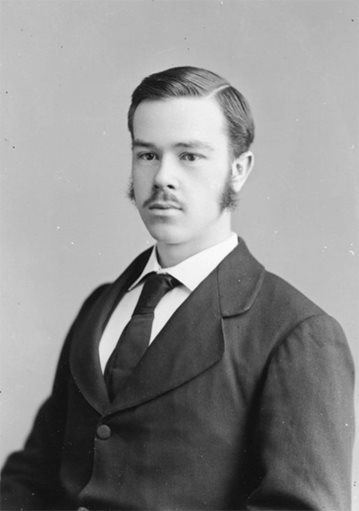 The Reverend Michael Brennan (1796-1869), first pastor of St.Michael's Roman Catholic Church, Belleville, was one of the leaders of sympathizers who sought to have the death penalty for Richard and Mary Aylward rescinded.St. Michael's Roman Catholic Church Archives
The Reverend Michael Brennan (1796-1869), first pastor of St.Michael's Roman Catholic Church, Belleville, was one of the leaders of sympathizers who sought to have the death penalty for Richard and Mary Aylward rescinded.St. Michael's Roman Catholic Church Archives
At the time, few were convinced that the death sentence pronounced at their trial would actually be carried out. Petitions from neighbours and fellow Catholics claimed perjury and falsified evidence. The jury had strongly urged mercy. Even the convicted couple refused to accept their imminent death.
On the weekend before the scheduled execution, rumours circulated in Belleville that the gathering throngs would be denied the spectacle they were travelling for miles to see. In their separate cells in the Hastings County jail, the Aylwards took heart.
True, their judge, William Henry Draper, was the perfect symbol of a High Tory, Family Compact politician in Upper Canada. In the trial on October 20, Draper had been implacably on the side of the Crown.
Before he pronounced sentence, Mr. Chief Justice Draper solemnly warned the couple to expect no reprieve. They must devote themselves single-mindedly to seeking God’s mercy, for they would find none on this earth.
Far away, in Quebec City, was a new government, elected in the very month that the Aylward family had been caught in their own tragedy. Fed up with George-Étienne Cartier and his partner, John A. Macdonald, and by indifference to their demand for a voice equivalent to their burgeoning population, voters in Canada West had taken a chance on a moderate Reformer from Cornwall, John Sandfield Macdonald.
A Catholic at the head of a largely Protestant bloc in the Legislative Assembly, Macdonald held the post of attorney general. The Aylwards presented the kind of dilemma all politicians fear. The legal and factual details of the case hardly mattered.
In a Canada more cruelly divided by religion than by language or culture, backers of the former government would exploit whatever Sandfield Macdonald did for whichever denomination felt aggrieved. And Belleville’s Catholic parish priest had left no doubt that the Aylwards’ conviction for murder was a cruel injustice.
What had the Aylward’s done to risk the supreme penalty of the law? Mary O’Brien had been born in 1834 in Toor, a little village in the southeast corner of County Limerick in Ireland.
At the age of twelve, her parents sent her and her brother to join her older sister Ellen in Lakefield, Connecticut. Nine years later, she met Richard Aylward, who had emigrated from Carlow in Ireland in 1850 at the age of fourteen. Richard and Mary married at Poughkeepsie, New York, on August 15, 1855.
With 7 uniquely curated newsletters to choose from, we have something for everyone.
The young couple had decided to move in with Richard’s aunt, Mary Ann McRae, at Puslinch, near Guelph, in Canada West. In 1856, they moved 275 kilometres east to Kaladar in Addington County.
Five years later, they again moved, to property seventy kilometres north, near the village of Bancroft, in Hastings County, on the edge of the Canadian Shield, where free grants of hundred acres were offered to anyone willing to build a house of at least twenty-by-twenty-three feet and keep at least twelve acres in cultivation for five years.
Richard’s aunt had settled nearby. By July 1861, the Aylwards were established on Peterson Road with two daughters, a third about to be born, and very little else to show for their time in Canada. Richard
When the constable taking the Aylwards to jail in Belleville stopped for refreshment in Madoc (shown here in the 1860s), two of the prime pieces of evidence, the scythe and the shotgun, were taken by an unknown person.
Aylward set to work clearing a field and earning a few dollars by working for better-off settlers in the neighbourhood. Mary was left to manage alone. By her own account, two days after her baby was born, three men attacked her and her husband, knocking her unconscious with a handspike but failing to kick Richard Aylward to death.
The Aylwards’ neighbours on the other side of the road had been there since May 1861. William Munro and his wife, Chrystina Margaret, were Protestants, a lot older than the Aylwards, and relations never seem to have been very cordial.
Having sold Munro some hens, the Aylwards were dismayed that the birds were free to cross the road and forage in their brand new wheat field. This became an explicit source of bad relations. Later, Mary Aylward claimed that when she tried to drive the hens from her farm, Munro threw stones at her and shouted abuse.
When Munro was busy, his son Alexander (Alick) echoed his father’s behaviour. For several days Aylward was summoned home to protect his anxious wife.
On May 16, 1862, Aylward came in from his day’s work, sat down to await dinner, and was playing with the baby when he and his wife heard visitors in their yard. Munro, too, had come home, and his wife reported she had heard a shot from across the road. She also claimed one of their hens was missing. Munro and Alick decided to visit the Aylwards’ property.
When they crossed the road, Mary Aylward appeared with her babe in arms while the two other girls played in the yard. Mrs. Aylward recalled telling Munro to get off her property, to which the older man had replied: “I will not until I get ready, come out and put me from the door if you dare, you d--d w-h-e.”
Next, Mary’s husband appeared. Richard told Munro to get off his property. Munro refused to leave without his hen. Aylward replied that he had not shot the bird, but wished he had. Next the Munros headed west toward Aylward’s wheat field to hunt for their hen. Richard picked up his shotgun and followed them.
According to the younger Munro, at the wheat field, Richard turned and levelled his shotgun at the older Munro, who promptly grabbed the muzzle. Richard then pulled a two-barrelled pistol from his shirt.
William Munro knocked the weapon out of Richard’s hand and told his son to pick it up. Alexander turned his back on the two older men and found the pistol nine or ten metres away. When he rose with the weapon in his hand, Aylward turned his gun toward the boy, who dropped to his knees.
Richard fired. The buckshot hit Alexander in the back over his left shoulder. The boy rose and ran for home, streaming blood but carrying the pistol. Later, he claimed, twenty-nine pieces of lead were extracted from his back.
Aylward and Munro were left wrestling for control of the shotgun when Mary Aylward appeared, carrying a scythe. She slashed at Munro, as hard as she could, striking his head and then his arm. It was William Munro’s turn to stagger home, collapsing inside his doorway in a pool of his own blood.
A week before, Richard’s cousin, Isabella McRae, recalled seeing Richard and Mary using the McRaes’ grindstone to sharpen the Aylward’s scythe. She recalled that Richard had claimed to be getting ready for haying. Since snow was still on the ground, this had struck her mother, Mrs. McRae, as odd.
On the evening of May 16, she remembered, Richard and his wife had returned. This time Mary Aylward loaded the shotgun from the McRaes’ supplies while her husband carried the scythe. “She said she had cut the head off the old man,” Mrs. McRae later recalled in court, “and that Richard had shot Alick.”
When Mrs. McRae expressed some skepticism, Mary Aylward showed her the blood on the blade. At that point, McRae’s son told the Aylwards to leave, and they did. Mrs. McRae hurried to the Munros’ cabin and found William still lying on his floor in a pool of blood and unable to speak.
Three days later, Mrs. McRae visited again. This time she found him in bed and able to talk, but so weak that, two days later, Munro confessed that he did not think he would live. He was right. William Munro died on May 28, 1862.
In frontier settlements, distances mattered. A neighbour named Finlayson set off for Madoc, 110 kilometres away, to summon Dr. Augustus Yeomans, the nearest coroner. On the way, he notified the reeve of Tudor Township, a Mr. Jelly, who summoned his neighbours and set off to arrest the murderers.
At dawn on Saturday, May 31, Dr. Yeomans set out on horseback. He reached Munros cabin at ten o’clock Monday morning. Examining the corpse, he found a large wound that had penetrated the left side of the skull down to the membrane, and another wound above the elbow of the left arm that had penetrated through half the bone.
“The injury of the head must, I think, certainly have occasioned death,” Yeomans concluded. Both blows had required great force. Still, Munro had lived for twelve days after his injury.
He had initially refused medical attention, but another neighbour, John Rous, had persuaded him to let an Indian doctor tend to the wound. There were no details of any resulting treatment, but the native healer seems to have removed the dressings, exposing the wounds and, local opinion agreed, hastening death.
On Saturday, Mr. Jelly’s posse arrested Mary Aylward. On the following Monday, after William Munros funeral, William Edes, the Hastings County constable, arrested both Aylwards. He asked for and secured the pistol, shotgun, and scythe, and carried them with him as he escorted his prisoners 100 kilometres south to the jail in Belleville.
Stopping for refreshment at a tavern on the way, some person “I don’t know who” took the scythe and shotgun. Despite offering a reward, Edes confessed, “I have not been able to recover it.”
The Aylwards were brought before a magistrate and lodged in separate cells to await the Hastings County autumn assizes, the Hon. W.H. Draper, chief justice for Common Pleas of Upper Canada, presiding.
Crimes, especially murder, fascinated Victorians, and they were a staple for pioneer newspapers. Reporters exploited their drama, mystery, and moral messages. Publishers recognized that they were cheap to cover. A journalist simply had to sit in the court and take notes. The first-ever trial of husband-and-wife murder suspects was an easy draw.
Mr. Chief Justice Draper was not quite the jurist that a judge-shopping attorney might have chosen for his clients. Draper had been the leading figure in Upper Canadian Toryism, an upholder of the Family Compact, and a politician who had tried in vain to defend the power of Canada’s most austere British governor, Sir Charles Metcalfe, against the proponents of Responsible Government. Defeated but unrepentant, Draper had retired to the judicial bench.
“If every man is to be permitted to take the life of his neighbour with impunity in defence of a bottle of whiskey we might as well reside in California as in Canada."
The Aylwards were also hapless enough to follow a trial that had deeply offended Draper’s stern sensibilities. After an affray over liquor near Belleville, Lorenzo Taylor, nineteen, had been left stabbed to death. Witnesses identified the killer as another young man named Maurice Moorman.
After deliberating for half an hour, the Belleville jury returned a not-guilty verdict. Moorman’s supporters “raised a cheer” in the courtroom, and a disgusted Draper scribbled in his desk book: “A strange verdict. I expected at least a verdict of manslaughter.”
So did the Belleville Chronicle. “If every man is to be permitted to take the life of his neighbour with impunity in defence of a bottle of whiskey, we might as well reside in California as in Canada. We trust that another verdict like this will never be recorded in Belleville.” Even before their trial began, word in the streets of Belleville was that the Aylwards were “doomed.”
Draper’s next trial, of course, featured Richard and Mary Aylward. By the time of the trial on October 20, several witnesses had been assembled for the Crown, represented by the solicitor general of Canada West, the Hon. Adam Wilson.
The Aylward defence team, financed by Belleville’s Roman Catholics, included James O’Reilly, a Kingston lawyer, and John Finn, a local man. The defence began by challenging fifteen of the jurors assembled by the sheriff, and ensuring that some of the twelve remaining members were Catholics. After the Crown had laid out its narrative of events, Wilson summoned Alexander Munro, the sole independent eyewitness of the events in the Aylwards’ field.
Calm and restrained, the young man made a good impression. He testified about the altercation, but he had not seen the blows to his father’s head and arm. He also confessed that he had never been on good terms with Aylwards, that he had said nothing during the afternoon, and had taken home the Aylwards’ pistol.
Mary Ann McRae was the Crown’s star witness. Her claim to have seen the Aylwards sharpening their scythe was evidence of the premeditation the Crown needed to prove murder rather than manslaughter.
Mrs. McRae was not shaken by O’Reilly, and she denied that she had ever said “I would wait in town and see these people hanged, or anything like it.”
Her daughter, Isabella, then testified that Mary Aylward had told her of a plan to tempt the deceased over their fence and into their house. Once Munro was at her door, she planned to shoot him and fetch male witnesses, including her husband, to see that Munro had pursued her into her own dooryard.
“She would talk in this boasting style of what she would do,” claimed Isabella.
Several witnesses testified to Mary Aylward’s desire to share the details of her crime. William Johnston, a neighbour on the same side of the road as the Aylwards, remembered seeing the couple coming along the road, Mary with the gun and Richard trailing the scythe.
“William Munro’s dead,” Mrs. Aylward had declared, adding, “I did not mean to hit him on the head. I meant to hit him on the neck and cut his head off.”
Johnston had followed the accused to the McRaes’, where Mary had learned that Munro was still alive. “God Almighty increase his pain” was her response. Richard, as usual, said nothing. Mary Aylward persuaded Margaret Glen to visit the scene of the fight.
The sight of Munro’s damaged hat on the field was evidence enough for her: “I said it would give her a great deal of trouble. She said it would give her no trouble, that if it was to do she would do it again” — a claim Mary repeated to another witness, Theophilus Golder, who lived farther down the Peterson Road.
Why was there such hatred? George Selby, a more distant neighbour, had called on the Aylwards after Munro’s funeral.
“Prisoner Mary told me [the] deceased was in the habit of coming opposite the house abusing her, and calling her improper names,” Draper’s notes recorded, “and that she had given it to him for now, and she wished she had given him another blow, and finished him off at once.”
Save as much as 40% off the cover price! 4 issues per year as low as $29.95. Available in print and digital. Tariff-exempt!
At the time, Mrs. Aylward was under arrest, and someone might well have advised her that she was incriminating herself. In the absence of a murder weapon or an uninvolved eyewitness, Mary’s own mouth provided the Crown’s chief evidence.
Later, in a letter to her youngest children, she would deny the evidence and insist that Mrs. McRae had perjured herself, but the variety and solemnity of the witnesses obviously convinced the jury and particularly Judge Draper. Mary’s conduct may have reflected her belief that any wife protecting her husband’s life on their own property would be immune from condemnation.
That was not James O’Reilly’s theory. Instead, his interpretation was that Mary’s ravings were an insane reaction to her horror at being driven to homicide to protect her endangered husband. Nonsense, responded the Crown. By sharpening the scythe and following her husband to the wheat field, Mary Aylward had carried out her part in a murderous conspiracy.
In less than a single day, the testimony was complete. Except for John Rous, who had advised Munro to have the Aylwards arrested and reported the unexpected reply from Munro that he “had no business interfering with them,” the defence rested its case.
O’Reilly had promised more witnesses than he produced, perhaps because Aylward sympathizers were too poor to make the long journey south to Belleville in early winter weather. After O’Reilly addressed the jury, so did Adam Wilson for the Crown. Then the chief justice summed up the case in terms that left little room for another Moorman verdict.
Draper had obviously been horrified by testimony that Mary Aylward had wished added pain and an early death for “Old Baldy,” as she had called Munro. If the jury believed that her self-incrimination was due to insanity, he warned, every hardened criminal would make the same claim. If the jury had doubts, they must give the benefit to the accused; Draper obviously had none.
After deliberating for two hours, the jury returned. Its foreman, Richard Bird, announced the verdict: “guilty with a strong recommendation for mercy.” Having jotted in his casebook that the jury had offered no reasons for its recommendation, Draper promised to pass on their views to the Executive and turned to the accused:
I must tell you that the law allows me no discretion in the matter. I will lay the case before the proper authorities but I deem it my duty to warn you not to spend the short time which outraged humanity yet allows you in the world in vain hopes and useless endeavours for mercy.
The Aylwards would be “taken to the place of execution and be there hanged by the neck until you are dead.” The Aylwards did not soften the judge’s heart. “You may hang away,” shouted Richard. “I am not guilty.” His wife echoed him, “Yes, they may hang away, we are innocent,” adding a little mysteriously,
“Doyle and Rowdy committed the murder and laid it on us.” Far from looking downcast or penitent, the Chronicle’s reporter observed “the prisoners spoke to one another and laughed in an unfeeling manner. Having seen each other only during the short trial, the couple was again separated and despatched to their cells to await their fate.”
In fact, “vain hopes and useless endeavours for mercy” would preoccupy them and their growing number of friends and allies.
Father Michael Brennan of Belleville’s St. Michael’s Church, also an Irish immigrant, and his nephew and curate, Father John Brennan, had befriended the Aylwards as soon as they were imprisoned, helped find them counsel, and encouraged parishioners to petition on their behalf. The Brennans insisted to the congregation and to anyone else who would listen that Mary’s conviction should be reduced to manslaughter and that Richard be unconditionally released.
John Finn, their lawyer, took a petition north to Madoc and to the settlers of Hastings Road. James Kennedy tried to compensate for the humble circumstances of the Aylwards by claiming that his forty signatures were from “gentlemen of the greatest intelligence and highest standing in this county.”
He noted the influence of the Moorman case, and also insisted that the killing had occurred far from law and magistrates, “where every one thinks it is proper to defend his supposed rights by the strong hand.” Signing such a petition was hard to resist. It cost nothing and retained a neighbour’s good will.
To refuse, as a Toronto Globe article noted, imperilled friendship and threatened the immense guilt that would follow if a condemned person were suddenly proved innocent. However, petitions also undermined a justice system that was assumed to be among the glories of English civilization — except, of course, among Irish Catholics who had felt the heavy hand of Anglo-Protestants since 1688 when Catholic James II was deposed as king of England.
Mary Aylward had made statements in moments of passion and excitement “not knowing what she was doing or saying” argued a petitioner. Another insisted that Munro and his son had “irritated them in a most provoking manner” by coming unbidden on the Aylwards’ land and remaining there.
Another argument was that Munro’s death was due to “an Indian ‘quack doctor,’ at a time when the patient was progressing favourably.” Above all, the prisoners were parents of three small children, one of whom, an infant in arms, shared her mother’s jail cell. John Finn even forwarded a petition from Alexander Munro and his mother Chrystina, “her mark (X),” asking that the Aylwards’ sentence be commuted to a life sentence.
The religious dimensions of the Aylward case caused John Sandfield Macdonald’s government obvious embarrassment. As a Catholic, Macdonald’s sympathy was demanded by his coreligionists; as the head of a fragile, Protestant-dominated coalition, it could not be given.
As a man of principle, could the attorney general for Canada West let politics control his judgment? Chief Justice Draper certainly saw no reason to soften the sentence:
Taking this woman’s whole conduct through the whole case, we find nothing but the most cold-blooded barbarity, and not an act committed in the heat of passion. The sharpening of the scythe, the showing Johnston how she intended to cut his head off — her conduct at Mrs. McCreas [sic] showing the scythe yet reeking in blood, when she is ordered out of the house.
The Aylwards had ignored Draper’s advice. Confident of commutation, they showed no signs of humble repentance.
On the Saturday before the execution, Mary Aylward issued a statement denouncing “the calumnious fabrication” that she and her husband were actually brother and sister.
A final petition from John Finn appealed for a month’s delay for the prisoners “owing to the fact that they are not spiritually prepared” arrived in Quebec almost too late to be considered. Father Michael Brennan passed on a claim that Mary Aylward was pregnant.
From Quebec, the government directed that Mary Aylward be examined by the prison doctor and one or two of the prison’s matrons. On December 2, Dr. Hope and Ann Dafoe, the jailer’s wife, reported that “by examination” and “her own statement” the prisoner was not bearing a child. The law was left to take its course on December 8.
The Aylward’s execution was covered in detail by the Hastings Chronicle and the Belleville Intelligencer. The reports were reprinted in papers across the Canadas. By dawn, close to a thousand people, “a moving tide of humanity,” covered the courthouse square in front of the gallows.
Ultimately more than five thousand stood in the bitter cold: “There were old men with whitened locks and bent forms, and infants nursing at their mothers’ breasts, young men and maidens, boys and girls of all sizes and ages.” There were cases of frostbite in the crowd, and the Chronicle deplored the fights, wrestling matches, and public drunkenness among young men in the throng.
When the promised deadline of ten o’clock passed, there were “cries of ‘Get them out here,’ ‘Hang them’ and the like filling the air.” Someone had forgotten to sew up the linen caps that would cover the victims’ heads.
At 11:25 A.M. the procession finally appeared, led by a couple of deputy sheriffs and bailiffs and a hooded hangman, followed by Mary Aylward “with deathly pallor on her countenance” and a trembling Richard Aylward.
“Mary was dressed all in white, with a crepe shawl covering her shoulders,” and both prisoners wore a noose, ready to be hooked to the gallows.
Since Victorians often believed that criminality was evident in a villain’s appearance, the Aylwards were a disappointment. Richard, at twenty-six years of age, was “rather well-proportioned,” with prominent cheekbones and a low forehead, but Mary, at twenty-eight, did not look her part at all.
“Her appearance is prepossessing,” claimed the Intelligencer, “and few would believe, judging from her countenance, that she could commit the fearful crime.” The reporter continued: “About medium height, dark hair, fair complexion, a bright eye, features well proportioned, and an intelligent look, the impression of her character upon the casual observer, is a favorable one.”
On the scaffold, the Aylwards fell to their knees to pray with Father John Brennan. When he lifted them to their feet, the hangman, “a short, thick-set men, dressed head to toe in a face-covering white gown,” hooked on their nooses and covered their heads with the newly made hoods. The priest looked to Richard, but not Mary, for any final words.
“The young man was too distraught in emotion, too broken in spirit to speak,” claimed a reporter, so Father Brennan begged the crowd to seek God’s mercy on the Aylwards’ souls. The crowd, noted the Chronicles reporter, neither heard nor cared. “They were there to see the Aylwards hang.” They got their wish.
As the priest stepped back, he collapsed in a faint and was carried unconscious from the scaffold. The hangman jerked back the bolt that held the two trap doors under the Aylwards, and the two bodies fell into the void. Spectators strained to see the results:
“Mary's frail body contorted like a grotesque puppet on tangled strings for a minute and a half until life deserted her. Richard continued to struggle for a further minute ... before he too found final peace.” The bodies were left hanging for a further twenty-five minutes “for the satisfaction and pleasure of those who came to witness their death.”
Later, at 3 P.M., a horse-drawn wagon took two simple caskets a few hundred metres down Church Street to St. Michael’s for the funeral.
The Catholic church was filled to capacity. Barely recovered from his collapse, Father Brennan mounted to the pulpit to proclaim the Aylwards’ innocence. The jury, he complained, had committed the folly of seeking mercy where there was no mercy to be found, a state of affairs that the Irish could recall from the days of Oliver Cromwell.
Frequently he broke down in tears, and his sobs brought echoing sobbing from his congregation. A sympathetic family soon adopted the Aylwards’ two older daughters; another family took the baby girl.
The younger Father Brennan took his convictions to Montreal, to the Irish communities of Canada East, where he interpreted the Aylward case as Protestant malevolence against Catholics worthy of Cromwell, hyperbole for which George Brown’s Globe later delivered a stern scolding:
The Government’s refusal to revise the judgement pronounced by the court and forthwith a “feeling” was put up against them. Party machinery was set to work, party orators denounced the law officers as murderers; party newspapers labored to present evidence clearly proving guilt into positive proof of innocence; all contrived to make it appear that the wretched beings who ended their lives upon the scaffold were martyrs to political hate. Simply for his refusal to assist in obtaining a commutation of sentence, the present speaker of the Assembly, Mr. Wallbridge, was denounced in partisan papers as the vilest of living things.
Lewis Wallbridge, the Assembly member for Hastings South, a moderate reformer, had been elected as Speaker of the House in the summer of 1862, while Cartier and other Lower Canadian bleus denounced his refusal to sign an Aylward petition as proof of his anti-Catholicism.
Though a convert to John A. Macdonald and Confederation in 1867, his memory of the vilification helped persuade him not to run. In 1878, when Wallbridge sought election again, his Dictionary of Canadian Biography contributor claims, Catholics were still waiting for him and he was again defeated.
Until 1893, the accused could not be called as a witness. Mary Aylwards version of events became known only after her death, when two letters to her children, dictated to Mrs. Grant on the Saturday before her execution, appeared in both the Chronicle and the Intelligencer.
To Ellen, her eight-year-old daughter, Mary Aylward left the care of her two younger sisters and a bitter account of repeated provocation and brutality by the Munros, father and son, culminating on May 16.
She had, she insisted, come to her husband’s aid after she heard the older, stronger Munro “swearing by his Jesus that he would shoot him with his own gun in place of him shooting the hens.”
Then she saw Alick pointing the pistol at her husband. “I saw the old scythe lying on the ground a few rods ahead of me. I took it up and ran up towards him; your Pa was down and I ran up and hit Munro one stroke.”
She did not know which man she had struck nor, until she saw Alick’s “back on fire,” had she any idea who had fired the shot.
Mary’s other letter, to her “dear little Infant Daughters,” begged them to remember her and her love for them, and left them with one wish, “as coming from the deathly lips of your mother, namely that you will attend to your religious duties. ... O what a cruel fate to be taken away from my infant children so young. God forgive those who are the cause of it.”
Forgiveness was mixed with a lively memory of those who had done her wrong, from Isabella McRae, who had lied about her, to three men, John and Martin Reddy and Michael Doyle, who had attacked her two days after her confinement with her baby, and had tried to kick her husband to death.
Presumably these were “Rowdy and Doyle,” whose names she had uttered after her sentence had been pronounced. Mary Aylward concluded the letter with forgiveness for more of Munro’s villainy: “I suspect that Munro did throw a dead dog in my own well or where I was taking water, and asked how I liked the soup of it.”
Both letters were co-signed by her husband with “I concur in the foregoing statement.” J.P. McDonnell, Mrs. Grant, her jailer, Zenas Dafoe, and his wife witnessed the signatures.
Mary Aylward had persuaded Father Brennan of her innocence of murder; she had not convinced her defence counsel. Instead, her repeated self-incrimination had burned the memory of both judge and jury. In his summation, Draper had dismissed as absurd the proposition that Mrs. Aylward had conveniently found a scythe lying in the wheat field. Yet not even Alick Munro remembered seeing her with it or wielding it.
On the other hand, Dr. Yeomans had found two deep and distinct cuts on Munro’s head and his arm. Too many witnesses had testified to Mary Aylward’s bloodthirsty boasting to easily undermine the verdict or even to see her as a wronged and frightened woman.
A later generation may be appalled at Mary Aylward’s fate and still wonder why her husband, who had killed no one, should be hanged beside her. A seemingly hapless cipher, Richard paid in full for the Victorian assumption that a husband was responsible for his wife’s behaviour.
“The past is a foreign country,” claimed British novelist L.P. Hartley. “They do things differently there.” Canada West in 1862 was a country in which we would prefer not to live.
We hope you’ll help us continue to share fascinating stories about Canada’s past by making a donation to Canada’s History Society today.
We highlight our nation’s diverse past by telling stories that illuminate the people, places, and events that unite us as Canadians, and by making those stories accessible to everyone through our free online content.
We are a registered charity that depends on contributions from readers like you to share inspiring and informative stories with students and citizens of all ages — award-winning stories written by Canada’s top historians, authors, journalists, and history enthusiasts.
Any amount helps, or better yet, start a monthly donation today. Your support makes all the difference. Thank you!
Themes associated with this article
Advertisement

